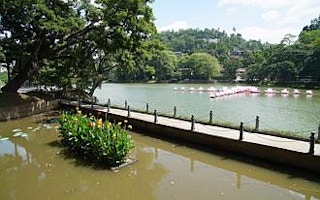Constructed as an ornamental lake between 1810 and 1812 by the last king of the Kandyan Kingdom, the fabled Kandy Lake has seen better days.
Urbanisation and the discharge of waste into waterways feeding the lake have caused serious water pollution, with fishes dying and the mid-canal, which runs from the lake through the city, becoming a breeding ground for mosquitoes, as residents told this reporter.
The lake lies in the heart of Kandy, a United Nations Educational, Scientific and Cultural Organization (UNESCO) World Heritage city in Sri Lanka, and covers an area of about 0.25 sq km.
For the past few months, professors and students from Singapore’s Nanyang Technological University (NTU) - under a pilot project that is part of the Lien Environment Fellowship programme - have been working to make the lake cleaner.
The professors had come up with a simple yet effective solution - placing floating platforms filled with a local plant called Cannas in the lake. These floating wetlands would serve as a purifying system, apart from beautifying the lake.
Since the middle of last year, three such floating platforms have been placed in the lake and the results were positive: Water pollution levels have gone down 60 per cent per cubic metre of water.
Over the next three years, the project aims to place another 100 floating platforms in the lake, at a cost of S$70,000.
The benefits include lower water bills for the residents, as the city authorities will require less money to treat the water.
Apart from the NTU professors, six undergraduates are also part of the project. Four of them visited the city two weeks ago to continue their work in educating the city’s children, setting up a wetlands club at a top girls’ college in Kandy to train the students to be “environmental ambassadors” and teach them to investigate scientific problems.
One of the undergraduates, Ms Valencia Evelyn, 23, said: “(The girls) didn’t know what they could do as a community to improve the (pollution) situation. They are very enthusiastic now, and even go around homes by the canals to spread awareness.”
The undergraduates also collected samples from the river to assist the professors in testing pollution levels.
Professor Ng Wun Jern, executive director of the Nanyang Environment and Water Research Institute, noted that the Singaporean students involved in the project had an opportunity to “see a situation they cannot imagine”.
He also cited the possibility of adapting the project to Singapore. “We should also look at the project in terms of scalability, it would be nice if we can transfer that to our community,” he said.
The NTU is partnering Sri Lanka’s University of Peradeniya for this project and professors from the university have visited Singapore’s floating wetlands at Kranji and Jurong.
The project is the first of seven under the Lien Environment Fellowship programme, which funds projects to improve water, sanitation and renewable energy in less-developed countries in Asia. Its other projects include deriving energy from organic waste in India and developing clean water and sanitation systems in Myanmar.








